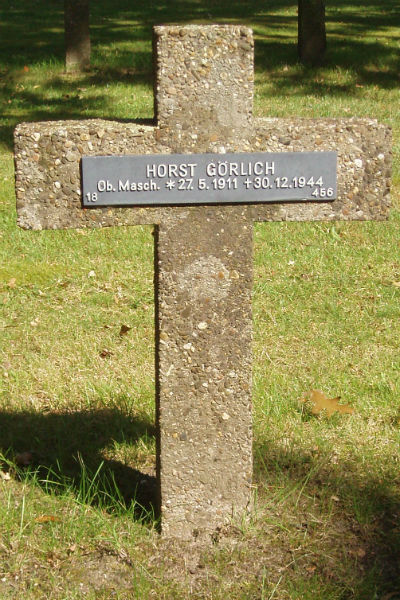Görlich, Horst Ernst
- Date of birth:
- May 27th, 1911 (Leipzig)
- Date of death:
- December 30th, 1944 (Henri-Chapelle, Belgium)
- Buried on:
- German War Cemetery Lommel
Plot: 18. Grave: 456. - Service number:
- 097/40 ET
- Nationality:
- German
Biography
Horst Görlich was the son of pharmacist Ernst Görlich. From 1922 the mother is listed as main occupant in the Leipzig address books. We must conclude from this that the father died in 1921. Horst was just 10 years old at the time. The exact date of death of Görlich Sr. is not known. The mother did not remarry after the death of her husband and raised the two children, Horst had a sister who was a little older. Horst Görlich's sister died in 1982, she was never married and remained childless. After the death of father Görlich, mother managed to keep her head above water by first running a bakery branch, later trading in books. This data could be reconstructed thanks to historical veins books. The mother died at the beginning of 1940. The data from the Nürnberg City Archives show that Horst Görlich learned to be a blacksmith. It is not known to what extent he completed the training. He eventually went into shipping Thanks to the records kept by the then Seemannskasse, we know today where, when and with which ship Horst Górlich was en route. The administration needed to be able to claim a pension. today the Seemannskasse and the administration for the German Railways are together in one organization. Horst Görlich was, among other things, in the process of fishing. He worked as a stoker for "Nordsee" Deutsche Hochseeficherei. Since the 1920s, Horst Görlich moved several times. Often he moved towards Hamburg and Cuxhafen, but Leipzig always was his main anchorage.
Görlich married in 1939, but the marriage remained childless. Horst Görlich's widow died in 1986. Little is known about the time Horst Görlich stayed with the German navy. The administration of the Seemannskasse shows that he was called 1940 and a second time at the end of February 1941. The only communication from the Deutsche Dienststelle is dated early 1943, he served on minesweeper 25 (Rio). His position there was Obermachinist. In 1940 he ended up with a broken ankle in a field hospital in Oslo. Unfortunately it was not stated where he came from and where he was sent in March 1943. Even in his case, the road to the Ardennes remained in the dark. Görlich was part of a group of 7 which was arrested at Géromont. In the possession of the family of one of the other members of this group is a document translated into German, a summary of the process. However, it has not yet been possible to uncover the original document.
The other 6 members of this group were: Arno Krause, Rolf Meyer, Erhard Miegel, Robert Pollack, Günther Schilz and Dietrich Wittsack. The members of this group were executed in Henri-Chapelle on 30.12.1944. Here too it is not certain whether it is the same location as the Billing team. A special feature is that the 13. Fallschirm Regiment is stated as a unit on the death certificate of the International Red Cross in Geneva. This unit is on all certificates in this group. However, the explanation can be strongly disputed since in no source this group is linked to the said unit. In the book "History of the C.I.C." John Mendelsohn states that the group was a member of the Einheit Stielau. And since Mendelsohn literally quoted US Army reports (even pictured) there is no doubt about that. The message and more can be found in the extensive biographies of Görlich and the other executed members of this operation Greif, see source reference at the bottom of the page.
Do you have more information about this person? Inform us!
Sources
- Photo 1: Wolfgang Stienes
- - oorlogsslachtoffers.nl
- Translation: Martin Wilders



